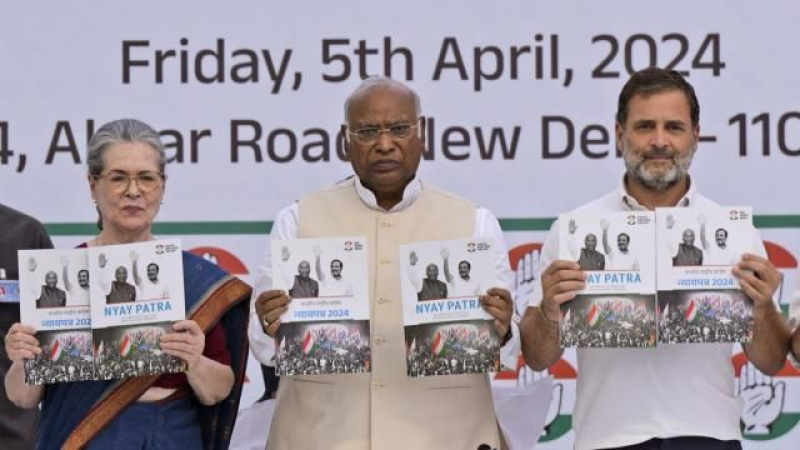- Resumption of US Tests May Trigger Threats from Other Nuke Powers |
- Zubaida goes to Evercare again at night to stay beside Khaleda |
- Urgent earthquake preparedness underlined to minimise damage |
- International Day of Persons with Disabilities celebrated at Barura |
- Bangladesh achieves 97% typhoid vaccine coverage for children |
India's nat’l polls will take place in phases over 44 days
Here is why it takes so long

Indian opposition staged road march across the country in the run-up to the election. AP Photo
NEW DELHI, Apr 15(AP/UNB) — Nearly 970 million people — or over 10% of the global population — are eligible to vote in India's general elections that start Friday and last to June 1. The mammoth exercise is the biggest anywhere in the world and will take 44 days before results are announced on June 4.
Prime Minister Narendra Modi is seeking a third successive term. He will face off against a broad but flailing alliance of opposition parties that are struggling to challenge his appeal. Most surveys predict Modi’s Hindu nationalist Bharatiya Janata Party will win comfortably, cementing him as one of the country’s most popular and consequential leaders.
WHY DOES IT TAKE SO LONG?
It boils down to two key reasons: the sheer size of India, the world’s most populous country, and the astonishing level of logistics needed to ensure that every registered voter is able to cast their ballot.
Over the years, the duration of voting has wavered. It took nearly four months to complete the vote in India’s first elections in 1951-1952, after it gained independence from British rule, and just four days in 1980. In 2019, voting took 39 days, and this year’s election is the second longest.
With 969 million registered voters, the size of India’s electorate is bigger than the combined population of the 27 European Union member states. This includes 18 million first-time voters, and around 197 million who are in their 20s.
The vote to choose 543 lawmakers for the lower house of Parliament takes place over seven phases. India’s 28 states and eight federal territories will vote at different times. Each phase is one day, with the first held on April 19 and the last on June 1.
While some states will cast their ballots in a day, voting elsewhere may take longer. The largest state, Uttar Pradesh, which is the size of Brazil with 200 million people, will vote on all seven days, for example.
General elections in India tend to take weeks to conduct, but Modi’s opponents also say it gives him an advantage as it makes it easier for the prime minister, the public face of the BJP, to travel and campaign, especially in states where they are weak.
EVERY VOTE COUNTS
The Election Commission of India, which oversees the vote, has to make sure there is a voting booth available within 2 kilometers (1.2 miles) of every voter.
"Election officials have to travel to great lengths to ensure that even a single voter can exercise their franchise,” said Chakshu Roy of PRS Legislative Research, an independent think tank.
Some 15 million election officials and security staff will traverse the country’s deserts and mountains — sometimes by boat, foot and even on horseback — to try to reach every voter.
It can be especially arduous. In 2019, when India last held elections, a team of polling officers trekked over 480 kilometers (300 miles) for four days just so a single voter in a hamlet in the remote state of Arunachal Pradesh, which borders China, could exercise their right.
Officials also traveled to a village tucked away high up in the Himalayas in 2019 to install a booth at 15,256 feet (4,650 meters), the highest polling station anywhere in the world.
This time too, polling stations will be installed in remote places, including one inside a wildlife sanctuary in southern Kerala state and another in a shipping container in western Gujarat state.
TIGHT SECURITY
Experts say a key reason behind the multiphase elections in India is about security.
Tens of thousands of federal security forces, who usually guard borders for instance, are freed up and deployed alongside state police to prevent violence and transport electoral officials and voting machines.
Deadly clashes involving supporters of rival political parties, particularly in the eastern state of West Bengal, had marred previous elections. But such violence has tapered over the years, thanks to heavy security, and voting has been relatively peaceful.
“Look at the geography of the country … there are rivers, mountains, snow, jungles … think of the security forces’ movements. They will have to travel through the length and breadth of the country,” Rajiv Kumar, the chief election commissioner, said on Saturday. “We will walk the extra mile so voters don’t have to.”

